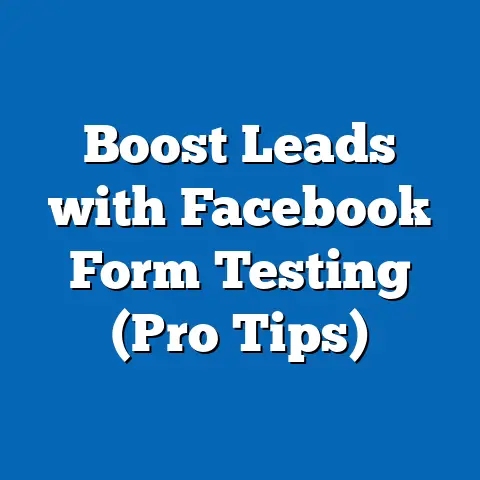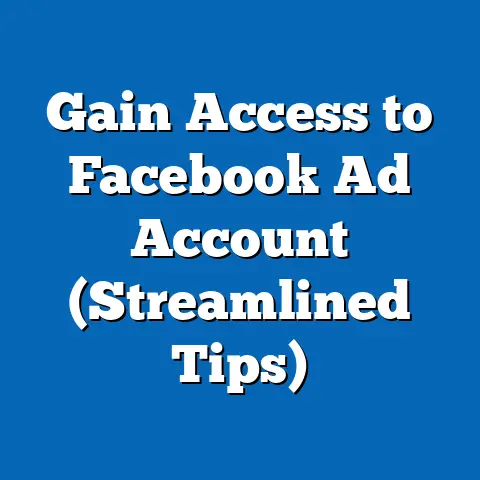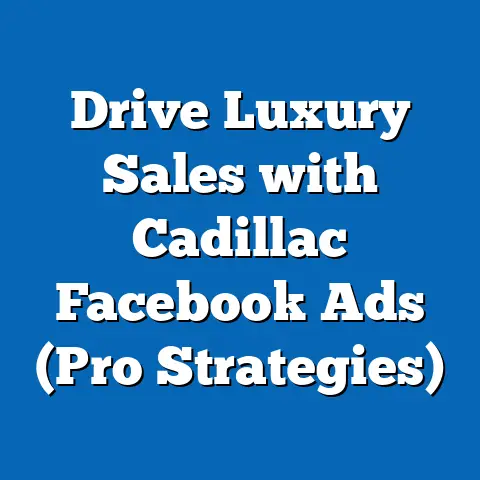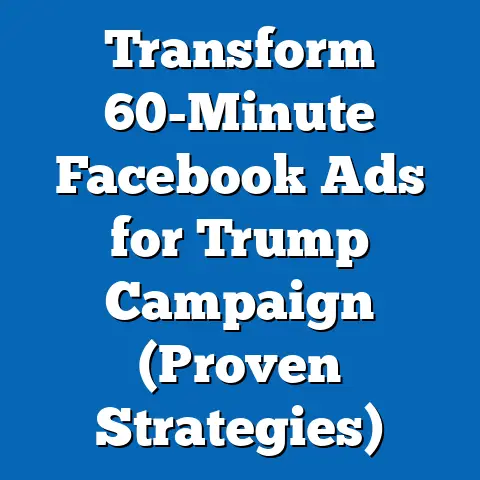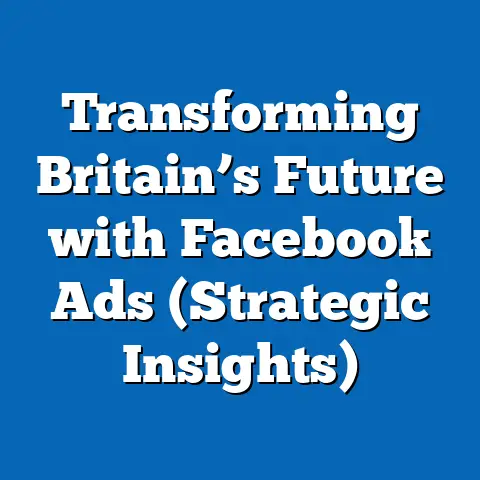Unleash Facebook Ad Library for Success (Insider Insights)
The world of digital marketing is a constantly evolving landscape, and if you’re not adapting, you’re falling behind. Nowhere is this more true than in the realm of social media advertising, especially when it comes to platforms like Facebook. We’re not just talking about keeping up with algorithm changes anymore. It’s about proactively shaping your strategies to not only succeed today but also anticipate and conquer the challenges of tomorrow. That’s why I am so passionate about the Facebook Ad Library – a powerful, often underutilized tool that can give you a significant edge.
Section 1: Understanding the Facebook Ad Library
What is the Facebook Ad Library?
At its core, the Facebook Ad Library is a public database that provides transparency into the ads running across Meta platforms, including Facebook, Instagram, Messenger, and Audience Network. Think of it as a searchable archive of active and inactive ads, offering a wealth of information about who is running what, where, and how.
A Brief History: Transparency and Evolution
The Facebook Ad Library wasn’t always around. It emerged as a response to growing concerns about political advertising and the potential for misinformation to spread on social media. Following scrutiny surrounding the 2016 US Presidential Election, Facebook committed to greater transparency in its advertising practices. In 2018, they launched the Ad Library, initially focusing on political and issue-based ads.
Accessing the Ad Library and Available Ad Types
Accessing the Facebook Ad Library is remarkably simple. You can do so by visiting the official Facebook Ad Library website. No special permissions or logins are required!
Once you’re there, you can search for ads based on keywords, advertisers, or specific topics. The Ad Library allows you to view a wide range of ad types, including:
- Image Ads: Ads featuring a single image or a carousel of images.
- Video Ads: Ads that utilize video content to capture attention and convey a message.
- Text Ads: Ads primarily relying on written copy to communicate with the audience.
- Lead Generation Ads: Ads designed to collect leads directly within the Facebook platform.
- Dynamic Ads: Ads that automatically display relevant products to users based on their browsing history and interests.
The breadth of ad types available in the Ad Library provides a comprehensive overview of the advertising landscape on Facebook, making it an invaluable resource for marketers.
Takeaway: The Facebook Ad Library is a powerful tool that offers unparalleled transparency into the world of Facebook advertising. Understanding its purpose, history, and available ad types is the first step towards unlocking its full potential.
Section 2: The Value of Competitive Analysis
Why Competitive Analysis Matters
Competitive analysis is the bedrock of any successful marketing strategy. It involves identifying your competitors, evaluating their strengths and weaknesses, and understanding their strategies. In the context of Facebook advertising, competitive analysis allows you to:
- Identify Opportunities: Spot gaps in the market that your competitors are overlooking.
- Improve Your Strategy: Learn from your competitors’ successes and failures.
- Differentiate Yourself: Develop a unique value proposition that sets you apart from the competition.
- Stay Ahead of the Curve: Anticipate emerging trends and adapt your strategy accordingly.
Leveraging the Ad Library for Competitive Insights
The Facebook Ad Library provides an unprecedented opportunity to analyze your competitors’ Facebook ad strategies. By searching for your competitors’ names or related keywords, you can gain valuable insights into their:
- Ad Creative: What types of images, videos, and ad copy are they using?
- Targeting Methods: Who are they targeting with their ads? What interests, demographics, and behaviors are they focusing on?
- Ad Spend: While the Ad Library doesn’t reveal exact ad spend, it provides a general indication of their investment in Facebook advertising.
- Promotional Offers: What types of discounts, promotions, and incentives are they offering?
- Landing Pages: Where are they directing users after they click on their ads? What kind of experience are they providing on their landing pages?
I remember one time I was working with a client in the e-commerce space, and we were struggling to gain traction with our Facebook ads. After spending hours analyzing our competitors’ ads in the Ad Library, we realized that they were heavily promoting user-generated content (UGC). We decided to incorporate UGC into our own ads, and it completely transformed our results. Our click-through rates skyrocketed, and our conversion rates doubled!
Identifying Trends and Patterns
Beyond analyzing individual competitors, the Ad Library can also help you identify broader trends and patterns in your industry. By searching for relevant keywords and topics, you can:
- See What’s Working: Identify common themes and approaches that are resonating with audiences.
- Spot Emerging Trends: Discover new ad formats, targeting strategies, and promotional tactics.
- Understand Seasonal Trends: Analyze how advertising strategies change during different times of the year.
This information can be invaluable for informing your own advertising strategy and ensuring that you’re staying ahead of the curve.
Takeaway: Competitive analysis is crucial for success in Facebook advertising, and the Ad Library provides a wealth of information for gaining insights into your competitors’ strategies, identifying industry trends, and improving your own campaigns.
Section 3: Navigating the Ad Library Interface
The Facebook Ad Library interface is relatively straightforward, but knowing how to use it effectively can save you time and help you uncover more valuable insights. Let’s walk through the key features and advanced search techniques.
Section 4: Analyzing Ad Performance and Engagement
Finding ads is only half the battle. Understanding how to analyze their performance and engagement is where the real magic happens. Here’s how to interpret the metrics available in the Ad Library.
Assessing Performance Metrics
The Facebook Ad Library provides limited performance metrics, but you can still glean valuable insights by analyzing:
- Impressions: While the Ad Library doesn’t display exact impression numbers, it does indicate the range of impressions an ad has received. This can give you a general sense of how widely the ad has been shown.
- Spend: Similar to impressions, the Ad Library provides a range of ad spend rather than precise figures. This can help you understand the level of investment your competitors are making in their Facebook ads.
- Demographics: The Ad Library shows the demographic breakdown of the audience that has seen the ad, including age, gender, and location. This can provide valuable insights into your competitors’ targeting strategies.
Analyzing Engagement Metrics
Engagement metrics are crucial for understanding how audiences are reacting to an ad. The Ad Library displays the following engagement metrics:
- Reactions: The total number of reactions (likes, loves, wows, etc.) an ad has received.
- Comments: The number of comments an ad has generated.
- Shares: The number of times an ad has been shared.
By analyzing these metrics, you can gauge the level of interest and resonance an ad has with its target audience. A high number of reactions, comments, and shares suggests that the ad is engaging and relevant. However, it’s important to also read the comments to understand the sentiment behind them. Are people praising the ad, asking questions, or expressing concerns?
Case Studies: Decoding Success
The Ad Library is a treasure trove of successful ad campaigns waiting to be analyzed. Here’s how to dissect a successful ad and understand what made it work:
- Identify the Ad’s Objective: What is the ad trying to achieve? Is it driving traffic to a website, generating leads, or promoting a specific product?
- Analyze the Ad Creative: What makes the ad visually appealing? Is the image or video high-quality and relevant to the target audience?
- Evaluate the Ad Copy: Is the ad copy clear, concise, and persuasive? Does it highlight the benefits of the product or service being advertised?
- Assess the Call to Action: Is the call to action clear and compelling? Does it tell users exactly what you want them to do?
- Examine the Targeting: Who is the ad targeting? Does the targeting align with the ad’s objective and the product or service being advertised?
- Consider the Landing Page: Does the landing page provide a seamless and relevant experience for users who click on the ad?
By thoroughly analyzing these elements, you can gain valuable insights into what makes a Facebook ad successful and apply those learnings to your own campaigns.
Takeaway: Analyzing ad performance and engagement metrics in the Ad Library can provide valuable insights into what’s working, what’s not, and how to optimize your own Facebook advertising campaigns.
Section 5: Crafting Your Own Ads Inspired by Insights
The insights you gather from the Ad Library shouldn’t be copied verbatim. Instead, view them as inspiration for crafting your own unique and effective ad campaigns. Here’s how to translate those insights into actionable strategies.
Elements of Successful Ad Copy
- Headline: The headline is the first thing people see, so it needs to be attention-grabbing and relevant. Use strong verbs, numbers, and questions to pique interest.
- Body Text: The body text should expand on the headline and highlight the benefits of your product or service. Keep it concise, clear, and persuasive.
- Call to Action: The call to action should tell users exactly what you want them to do. Use strong action verbs like “Shop Now,” “Learn More,” or “Get Started.”
Remember, the best ad copy speaks directly to the needs and desires of your target audience. Use the insights you’ve gained from the Ad Library to understand what resonates with them and tailor your copy accordingly.
The Power of Visuals
Visuals are a crucial component of any successful Facebook ad. Choose images and videos that are:
- High-Quality: Use high-resolution images and videos that are visually appealing.
- Relevant: Ensure that your visuals are relevant to your product or service and your target audience.
- Eye-Catching: Use visuals that stand out from the crowd and grab attention.
- Brand-Consistent: Maintain a consistent visual style that aligns with your brand identity.
Don’t be afraid to experiment with different types of visuals to see what works best for your audience. Test different images, videos, and ad formats to optimize your results.
Maintaining Brand Voice and Message Consistency
While it’s important to be inspired by other campaigns, it’s equally important to maintain your brand voice and message consistency. Your ads should reflect your brand’s unique personality and values.
- Use Your Brand’s Tone: Write your ad copy in your brand’s unique tone of voice. Are you playful and humorous, or serious and professional?
- Highlight Your Brand’s Values: Showcase your brand’s values in your ads. Are you committed to sustainability, social responsibility, or customer satisfaction?
- Maintain Visual Consistency: Use consistent colors, fonts, and imagery that align with your brand identity.
By maintaining brand voice and message consistency, you can build trust with your audience and create a strong brand identity.
Takeaway: Use the insights you’ve gained from the Ad Library to inspire the creation of effective ad campaigns, but always maintain your brand voice and message consistency.
Section 6: Future-Proofing Your Facebook Advertising Strategy
The Facebook advertising landscape is constantly evolving. To stay ahead of the curve, you need to future-proof your advertising strategy by:
Adapting to Changes in Ad Policies
Facebook regularly updates its advertising policies to address emerging issues and protect users. It’s crucial to stay informed about these changes and adapt your advertising strategy accordingly.
- Monitor Facebook’s Advertising Policies: Regularly review Facebook’s advertising policies to ensure that your ads comply with the latest guidelines.
- Stay Informed About Industry News: Follow industry blogs and publications to stay up-to-date on changes in the advertising landscape.
- Be Prepared to Adjust Your Ads: Be ready to quickly adjust your ads if they violate Facebook’s advertising policies.
Understanding Consumer Behavior
Consumer behavior is constantly changing, so it’s important to stay attuned to the latest trends and preferences.
- Monitor Social Media Trends: Pay attention to what people are talking about on social media and identify emerging trends.
- Analyze Your Audience Data: Regularly analyze your audience data to understand their demographics, interests, and behaviors.
- Experiment with New Ad Formats: Test different ad formats to see what resonates with your audience.
Embracing Emerging Trends
The digital marketing landscape is constantly evolving, with new technologies and trends emerging all the time. To stay ahead of the curve, you need to embrace emerging trends and incorporate them into your advertising strategy.
- Explore New Technologies: Experiment with new technologies like augmented reality (AR) and virtual reality (VR) to create immersive ad experiences.
- Embrace Personalization: Use data to personalize your ads and deliver tailored experiences to each user.
- Focus on Mobile: Ensure that your ads are optimized for mobile devices, as the majority of Facebook users access the platform on their smartphones.
The Importance of Continuous Learning
The key to future-proofing your Facebook advertising strategy is continuous learning. Stay curious, keep experimenting, and never stop learning.
- Attend Industry Conferences: Attend industry conferences and workshops to learn from experts and network with other marketers.
- Take Online Courses: Enroll in online courses to deepen your knowledge of Facebook advertising.
- Read Industry Blogs and Publications: Stay up-to-date on the latest trends and best practices by reading industry blogs and publications.
Takeaway: Future-proofing your Facebook advertising strategy requires continuous learning, adaptation, and a willingness to embrace change.
Section 7: Real-World Success Stories
Let’s bring these concepts to life with some real-world examples of brands that have successfully utilized the Facebook Ad Library to enhance their advertising strategies.
Case Study 1: E-Commerce Brand Boosts Conversions
An e-commerce brand selling sustainable clothing was struggling to stand out in a crowded market. By analyzing their competitors’ ads in the Ad Library, they discovered that many were focusing on price and discounts.
The brand decided to take a different approach, highlighting their commitment to ethical manufacturing and sustainable materials. They created ads that showcased the stories behind their products and the positive impact they were having on the environment.
As a result, their click-through rates increased by 30%, and their conversion rates doubled. They were able to attract a loyal customer base that valued their brand’s mission and values.
Case Study 2: Local Restaurant Drives Foot Traffic
A local restaurant was looking to drive more foot traffic to their establishment. By analyzing their competitors’ ads in the Ad Library, they noticed that many were promoting generic food photos and menu items.
The restaurant decided to create ads that showcased their unique atmosphere and customer experiences. They used high-quality photos and videos that captured the energy and vibe of their restaurant.
They also targeted their ads to local residents who were interested in dining and entertainment. As a result, their foot traffic increased by 40%, and their revenue soared.
Case Study 3: Software Company Generates Leads
A software company was struggling to generate leads through their Facebook ads. By analyzing their competitors’ ads in the Ad Library, they realized that many were focusing on technical features and product specifications.
The software company decided to create ads that highlighted the benefits of their software and how it could solve their target audience’s pain points. They used testimonials and case studies to demonstrate the value of their product.
They also targeted their ads to specific industries and job titles. As a result, their lead generation increased by 50%, and their sales pipeline grew significantly.
Takeaway: These real-world success stories demonstrate the power of the Facebook Ad Library to enhance advertising strategies and achieve measurable results.
Section 8: Common Pitfalls to Avoid
While the Facebook Ad Library is a powerful tool, it’s important to avoid common pitfalls that can hinder your success.
Don’t Just Copy, Inspire
The biggest mistake marketers make is simply copying their competitors’ ads verbatim. This is not only unethical but also ineffective. Your ads should be inspired by your competitors’ strategies, but they should also be unique and authentic to your brand.
Relying Solely on Competitors’ Ads
Don’t rely solely on your competitors’ ads for inspiration. Use the Ad Library as a starting point, but also conduct your own research and analysis to understand your target audience’s needs and desires.
Ignoring Ethical Standards
It’s important to maintain ethical standards when analyzing and drawing inspiration from competitors. Don’t steal their ideas or use their trademarks without permission.
Overlooking Negative Feedback
Pay attention to the comments and feedback on your competitors’ ads. This can provide valuable insights into what people don’t like and what you should avoid in your own ads.
Neglecting to Test and Optimize
Don’t assume that what works for your competitors will automatically work for you. Test different ad creatives, targeting strategies, and promotional tactics to optimize your results.
Takeaway: Avoid these common pitfalls to maximize your success with the Facebook Ad Library.
Conclusion: The Path Ahead
The Facebook Ad Library is more than just a database of ads. It’s a powerful tool that can transform your Facebook advertising strategy and help you future-proof your business. By understanding its purpose, navigating its interface, analyzing ad performance, crafting inspired ads, and avoiding common pitfalls, you can unlock its full potential and achieve measurable results.
As the digital marketing landscape continues to evolve, the Facebook Ad Library will become an increasingly valuable resource for marketers. Embrace the insights it provides, stay curious, and never stop learning. The path to innovation and success in Facebook advertising lies in your hands.
So, take action today. Dive into the Ad Library, explore your competitors’ ads, and start crafting your own unique and effective campaigns. The future of your Facebook advertising strategy is waiting to be unleashed!

